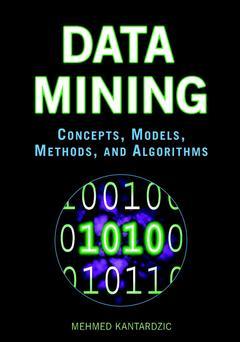Description
Data mining: concepts, models, methods, and algorithms
Author: KANTARDZIC Mehmed
Language: English
Approximative price 99.35 €
Subject to availability at the publisher.
Add to cart345 p. · 25.4x17.8 cm · Paperback
Description
/li>Contents
/li>
1 Data Mining Concepts.
1.1 Introduction.
1.2 Data mining roots.
1.3 Data mining process.
1.4 Large data sets.
1.5 Data warehouses.
1.6 Organization of this book.
1.7 Review questions and problems.
1.8 References for further study.
2 Preparing the Data.
2.1 Representation of raw data.
2.2 Characteristics of raw data.
2.3 Transformation of raw data.
2.4 Missing data.
2.5 Time dependent data.
2.6 Outlier analysis.
2.7 Review questions and problems.
2.8 References for further study.
3 Data Reduction.
3.1 Dimensions of large data sets.
3.2 Features reduction.
3.3 Entropy measure for ranking features.
3.4 Principal component analysis.
3.5 Values reduction.
3.6 Feature discretization: ChiMerge technique.
3.7 Cases reduction.
3.8 Review questions and problems.
3.9 References for further study.
4 Learning from Data.
4.1 Learning machine.
4.2 Statistical learning theory.
4.3 Types of learning methods.
4.4 Common learning tasks.
4.5 Model estimation.
4.6 Review questions and problems.
4.7 References for further study.
5 Statistical Methods.
5.1 Statistical inference.
5.2 Assessing differences in data sets.
5.3 Bayesian inference.
5.4 Predictive regression.
5.5 Analysis of variance.
5.6 Logistic regression.
5.7 Log linear models.
5.8 Linear discriminant analysis.
5.9 Review questions and problems.
5.10 References for further study.
6 Cluster Analysis.
6.1 Clustering concepts.
6.2 Similarity measures.
6.3 Agglomerative hierarchical clustering.
6.4 Partitional clustering.
6.5 Incremental clustering.
6.6 Review questions and problems.
6.7 References for further study.
7 Decision Trees and Decision Rules.
7.1 Decision trees.
7.2 C4.5 Algorithm: generating a decision tree.
7.3 Unknown attribute values.
7.4 Pruning decision tree.
7.5 C4.5 Algorithm: generating decision rules.
7.6 Limitations of decision trees and decision rules.
7.7 Associative classification method.
7.8 Review questions and problems.
7.9 References for further study.
8 Association Rules.
8.1 Market Basket Analysis.
8.2 Algorithm Apriori.
8.3 From frequent itemsets to association rules.
8.4 Improving the efficiency of the Apriori algorithm.
8.5 Frequent pattern growth method.
8.6 Multidimensional association rules mining.
8.7 Web mining.
8.8 HITS and LOGSOM algorithms.
8.9 Mining path traversal patterns.
8.10 Text mining.
8.11 Review questions and problems.
8.12 References for further study.
9 Artificial Neural Networks.
9.1 Model of an artificial neuron.
9.2 Architectures of artificial neural networks.
9.3 Learning process.
9.4 Learning tasks.
9.5 Multilayer perceptrons.
9.6 Competitive networks and competitive learning.
9.7 Review questions and problems.
9.8 References for further study.
10 Genetic Algorithms.
10.1 Fundamentals of genetic algorithms.
10.2 Optimization using genetic algorithms.
10.3 A simple...




